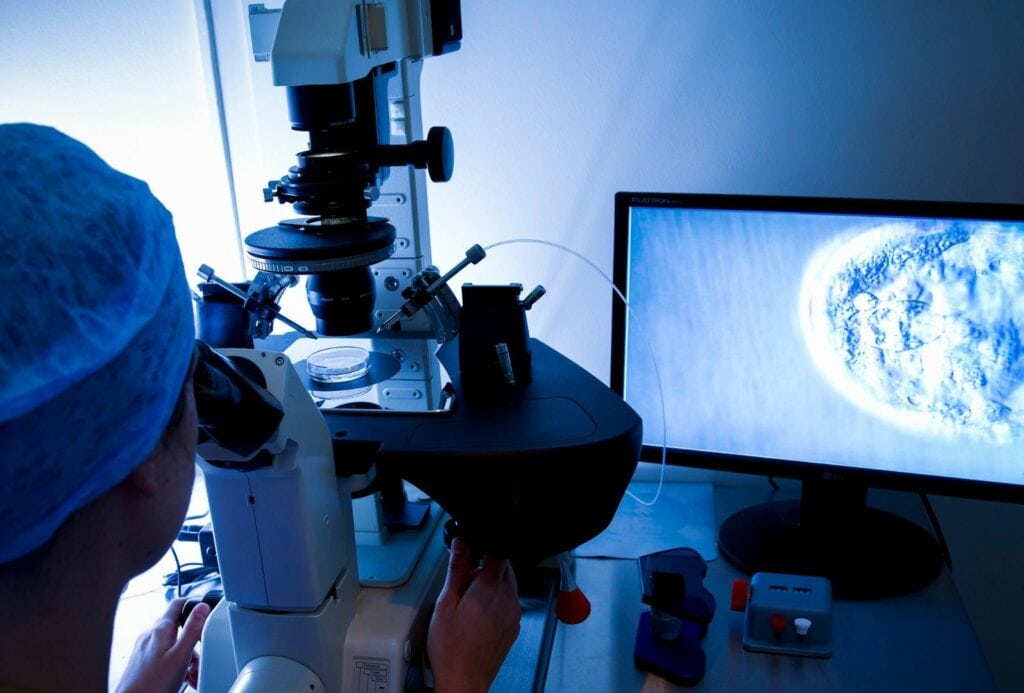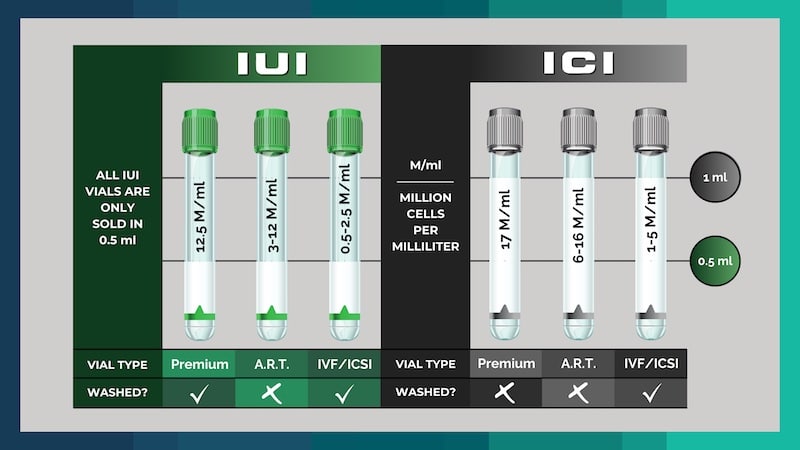We Offer Donor Storage Options Until You're Ready!
Are you planning to use donor sperm to conceive but aren't quite ready to get pregnant? Have you stumbled upon your perfect match before deciding you're ready to conceive? We understand that timing is everything when it comes to starting a family. Whether you're waiting for the perfect moment, focusing on your career, or want to ensure that your chosen donor's sperm is available when you're ready, Cryobank America has got you covered.
We offer a comprehensive sperm storage solution designed with your needs in mind. Our state-of-the-art facility ensures your chosen donor sperm is stored safely and securely until you're ready to use it. We adhere to the strictest standards of quality control and follow rigorous protocols to maintain the integrity of our stored specimens.
Donor Sperm Storage For Future Use
Finding the perfect donor is a significant part of your journey towards parenthood. We offer a database of diverse donor profiles for you to browse at your leisure. Each profile provides detailed information about the donor, including blood type, physical characteristics, CMV status, and more. This information allows you to make an informed decision about who will be contributing half of your future child's genetic material. You can find additional information on each donor when you sign up for our Premium Membership.
Once you've found your ideal donor, securing their sperm for future use is a simple process with Cryobank America. Our experienced professionals will guide you through every step, ensuring your experience is as smooth and stress-free as possible.
Will My Donor Sperm Be As Viable After Remaining In Storage?
Our cryopreservation process ensures that donor sperm can survive many years, maintaining its viability as if you had chosen to use it immediately. This advanced technology allows us to freeze and store sperm cells at extremely low temperatures, halting their biological clock and preserving their fertilization ability.
Our cryopreserved samples' longevity means you can plan your family at your own pace without the pressure of time constraints. Whether you're considering parenthood now or in the future, our services offer you the flexibility and security you need.
Donor Sperm Storage For Future Siblings
Storing your donor's sperm with us also opens up the possibility of having future siblings from the same donor. This option can be particularly appealing for those wishing to provide their child with a biological sibling connection later. We understand the importance of these familial bonds and are proud to facilitate such possibilities through our storage services.

Choosing Cryobank America
We understand this is a big decision, and we want you to feel confident in choosing Cryobank America as your partner in this journey. That's why we offer unparalleled customer service and support throughout the process. Our dedicated team is always available to answer any questions or concerns.
So, rest assured if you've found your perfect donor but aren't quite ready to conceive yet. Cryobank America will safely store your chosen donor sperm until you're ready. Trust us with your future – because at Cryobank America, we're not just storing sperm but safeguarding dreams.
- Protecting Your Health: Choosing A Sperm Bank Over Natural Insemination
- Hatching a Plan: Learning The Basics About Assisted Hatching in IVF
- Navigating GYN Surgery Before Artificial Insemination
- PGT Testing and Its Role in IVF Treatment
- The Ultimate Guide To Where You Can Donate Sperm In All 50 States
Reciprocal IVF: The Revolutionary Fertility Treatment for Lesbian Couples
Reciprocal IVF, also known as shared motherhood, is a breakthrough fertility treatment that has revolutionized the options available to lesbian couples who wish to have children. This innovative procedure allows both partners to actively participate in the conception and pregnancy process, creating a unique and special bond between them and their children. Reciprocal IVF has become increasingly popular among same-sex couples, offering a solution for those who want to experience the joys of biological parenthood.
What is Reciprocal IVF and How Does it Work?
Reciprocal IVF is a fertility treatment that allows lesbian couples to contribute genetically to the conception of their child. The process involves one partner providing the eggs while the other partner carries the fertilization of the eggs and donor sperm upon pregnancy. This unique approach allows both partners to have a biological connection to their child, creating a sense of shared parenthood.
The treatment begins with the partner providing the eggs undergoing ovarian stimulation to produce more eggs. Through a surgical procedure, the eggs are retrieved and fertilized with donor sperm in a laboratory. The cultured embryos are left to fertilize for a few days before being transferred into the partner's uterus, who will be carrying the pregnancy. If successful, the embryo implants in the uterus, and pregnancy begins.
In reciprocal IVF, each partner plays a crucial role in the process. The partner providing the eggs undergoes hormonal stimulation and egg retrieval, while the partner carrying the pregnancy prepares her uterus for embryo transfer. This collaborative approach allows both partners to actively participate in the conception and pregnancy journey, fostering a deep sense of connection and involvement.
The Benefits of Reciprocal IVF for Lesbian Couples
Reciprocal IVF offers several significant benefits for lesbian couples who wish to have children. Firstly, it allows both partners to have a biological connection to their child. This process is a unique and special opportunity for same-sex couples, enabling them to share the genetic bond with their child that is often taken for granted in heterosexual relationships. This biological connection can strengthen the emotional bond between parents and children, creating a sense of belonging and identity.
Secondly, reciprocal IVF provides a shared experience of pregnancy and childbirth. While one partner may be unable to carry the pregnancy due to medical reasons or personal preference, reciprocal IVF allows them to actively participate by providing their eggs. This shared experience can deepen the emotional connection between partners and create a sense of equality and partnership in the journey to parenthood.
Lastly, reciprocal IVF offers a solution for couples with fertility issues. If one partner has fertility challenges or cannot conceive naturally, reciprocal IVF provides an alternative path to parenthood. By using the partners' eggs with healthy fertility and donor sperm, the couple can overcome these obstacles and fulfill their dream of having a child together.
The Success Rates of Reciprocal IVF Compared to Traditional IVF
When considering fertility treatments, it is essential to understand the success rates of different options. Reciprocal IVF has shown comparable success rates to traditional IVF, with studies indicating that the chances of achieving a successful pregnancy are similar between the two methods. Factors that may affect success rates include the age and fertility of the partner providing the eggs, the quality of the donor sperm, and the overall health of both partners.
It is worth noting that success rates can vary depending on individual circumstances, and couples need to consult with their fertility specialist to understand their specific chances of success. Fertility clinics often provide statistics on their success rates, which can help couples make informed decisions about their treatment options.

The Cost of Reciprocal IVF: Is it Worth the Investment?
The cost of reciprocal IVF can vary depending on many factors. These factors include the location of the fertility clinic, the specific treatments required, and any additional services or medications needed. Reciprocal IVF can cost between $20,000 and $30,000 per cycle. This cost includes the expenses associated with ovarian stimulation, egg retrieval, sperm donation, embryo transfer, and any necessary medications or tests.
Couples need to consider the financial implications of reciprocal IVF and explore their options for insurance coverage or financing. Some insurance plans may cover some of the costs, while others may not provide any coverage at all. Couples should also research financing options such as loans or payment plans offered by fertility clinics or third-party organizations.
While the cost of reciprocal IVF may seem high, you should consider the long-term benefits and value of the treatment. For many couples, the opportunity to have a biological connection to their child and experience the joys of pregnancy and childbirth outweighs the financial investment. It is a deeply personal decision that each couple must make based on their circumstances and priorities.
The Emotional Journey of Reciprocal IVF: What to Expect
The partner providing the eggs may experience feelings of anxiety or pressure related to the success of the treatment and the quality of their eggs. They may also grapple with the emotional implications of using donor sperm and the potential impact on their relationship with their child. They must have open and honest conversations with their partner and seek counseling or therapy if needed.
The partner carrying the pregnancy may also experience various emotions, including excitement, fear, and anticipation. They may have concerns about the physical toll of pregnancy and childbirth and the potential impact on their career or personal life. They need to prioritize self-care and seek support from healthcare professionals or support groups that specialize in LGBTQ+ fertility.
Both partners should prepare for setbacks or challenges along the way. Couples should be open and honest with each other, express feelings and concerns, and seek professional help if needed. The emotional journey of reciprocal IVF can be intense, but couples can navigate it successfully with the proper support and resources.
Finding the Right Fertility Clinic for Reciprocal IVF
Choosing the right fertility clinic for the reciprocal IVF process is a significant step. There are several factors to consider when researching clinics, including their success rates, experience with LGBTQ+ patients, the range of services offered, and the overall atmosphere and environment of the clinic.
It is important to choose a clinic that has a proven track record of success with reciprocal IVF and a high level of expertise in LGBTQ+ fertility. Look for clinics with experience working with same-sex couples and a supportive and inclusive approach to care. Reading patient reviews and testimonials from individuals and couples who have experienced Reciprocal IVF can also provide valuable insights into the clinic's reputation and patient satisfaction.
When researching clinics, ask specific questions about their policies and procedures. Inquire about their approach to donor sperm and eggs, legal and ethical considerations, and support services for LGBTQ+ patients. You should feel comfortable and confident in the clinic's ability to meet your unique needs and provide the highest level of care.
The Role of Sperm Donors in Reciprocal IVF
Sperm donors play a crucial role in the reciprocal IVF process. When selecting a sperm donor, couples can choose one who matches their desired characteristics, such as physical appearance, ethnicity, or educational background. Selecting a donor allows couples to create a family that reflects their values and preferences.
The process of selecting a sperm donor involves working with a sperm bank that has a database of available donors. Couples can review donor profiles, which often include information such as physical attributes, medical history, educational background, and personal interests. Some sperm banks also offer the option of meeting the donor in person or having a phone consultation.
The Impact of Reciprocal IVF on the LGBTQ+ Community
Reciprocal IVF has significantly impacted the LGBTQ+ community, providing same-sex couples a viable and accessible path to parenthood. It has helped to challenge traditional notions of family and parenting, promoting inclusivity and acceptance of diverse family structures.
Reciprocal IVF has also played a role in advancing LGBTQ+ rights and recognition. Allowing same-sex couples to have a biological connection to their child has helped to challenge discriminatory laws and policies that deny LGBTQ+ individuals the right to parent. It has also contributed to a greater understanding and acceptance of same-sex relationships and families within society.
The Future of Reciprocal IVF: Advancements and Possibilities
The field of reproductive medicine is constantly evolving, and there are exciting advancements on the horizon for reciprocal IVF. Researchers are exploring new techniques and technologies that may improve success rates, reduce costs, and enhance the overall experience for couples.
One area of advancement is using preimplantation genetic testing (PGT) to screen embryos for congenital abnormalities before transfer. PGT can enhance the chances of a healthy pregnancy and minimize the risk of genetic disorders. Additionally, advancements in cryopreservation techniques allow couples to freeze and store donor sperm and embryos for future use, providing more flexibility in family planning.
Another area of research is the development of artificial gametes, which could allow same-sex couples to create embryos using their genetic material. While this technology is still in the early stages of development, it holds promise for the future of reciprocal IVF. It could further expand the options available to same-sex couples.
- Protecting Your Health: Choosing A Sperm Bank Over Natural Insemination
- Hatching a Plan: Learning The Basics About Assisted Hatching in IVF
- Navigating GYN Surgery Before Artificial Insemination
- PGT Testing and Its Role in IVF Treatment
- The Ultimate Guide To Where You Can Donate Sperm In All 50 States
How To Prepare For At-Home Insemination Before Placing Your Vial Order
At-home insemination is a method of assisted reproduction that allows couples to conceive without medical intervention. It involves using donor sperm to inseminate the female partner at home. You can use any of our vial options for at-home insemination. However, our premium IUI and ICI vials are recommended over all other options, which you can learn more about by clicking here.
One of the main benefits of at-home insemination is the privacy and convenience it offers. Couples can avoid the stress and expense of fertility clinics and have more control over the process. Whether you are purchasing donor sperm for at-home insemination or to have a procedure performed at your fertility clinic, our Clinic Release Form must be signed and submitted to us before you can complete your online purchase.
First Steps in Preparing for At-Home Insemination
Health & Wellness Check
Before placing your vial order with Cryobank America, ensuring both partners are in good health and have undergone necessary medical check-ups and testing is essential. This assurance includes checking for any underlying medical conditions affecting fertility and testing for sexually transmitted infections. It is also advisable to consult with a healthcare professional to ensure that at-home insemination is a safe and appropriate option for you.

Timing is Everything: Effectively Tracking Your Ovulation Before Scheduling Your Vial Delivery
Understanding ovulation and fertility is crucial for maximizing the chances of conception through at-home insemination. You must plan your vial delivery just before your fertility window.
Several methods are available for tracking ovulation, including tracking basal body temperature, monitoring cervical mucus, using ovulation predictor kits, or tracking changes in the cervix. Each method has advantages and considerations, so trying different ways to find the one that works best for you may be helpful.
Timing insemination correctly is crucial for increasing the chances of conception. That's why we don't consider ovulation-tracking mobile apps to be a reliable method. These mobile applications can only provide a vague approximate fertility window. Use ovulation testing kits designed to track ovulation precisely and provide detailed instructions. Typically, these kits will include testing strips that monitor the presence and concentration of luteinizing hormone (LH) in your urine, which appears about 12 – 36 hours before ovulation. Insemination should occur within a day or two before ovulation or on the day of ovulation itself. Perfectly timing insemination ensures that the sperm is present in the reproductive tract when the egg is released, increasing the chances of fertilization.
I Ordered Donor Sperm, and My Vials Are Out for Delivery. What's Next?
Once you've purchased your vials from Cryobank America and our team has coordinated an excellent delivery time based on your schedule, you will receive a USPS tracking code. Your tracking code will tell you the exact date and approximate delivery time.
Once your delivery arrives, you'll receive your vials along with our at-home insemination kit. Our kit includes a pre-charged dry shipper containing your purchased vials, complete documentation, and a sterile syringe.
Our dry shippers are pre-charged in our laboratory to remain active during shipping. They transport biological specimens safely and hold cryogenic temperatures of -150°C or colder. Our dry shippers are manufactured with compounds that absorb liquid nitrogen, ensuring there won't be any spills during shipping. Each dry shipper ships inside a protective container to provide an additional layer of protection.
Your At-Home Insemination Kit
Your delivery will also include four valuable pieces of documentation consisting of the following:
- A package summary. Your summary will list what you ordered, including the vial type, quantity, and total cost for your purchase. It will also include an analysis of your vial's motility and sperm count.
- Infectious Disease Report. This information includes your selected donor's most recent lab testing and infectious/non-infectious disease reports.
- Complete instructions. This paperwork will guide you on handling your dry shipper, thawing your specimen, and performing insertion.
- Package return slip. We will also provide a return slip for your dry shipper.
Lastly, you will receive a ready-for-use sterile syringe. Remember, you have seven days from the shipment date to complete the insertion. If shipping your vials and accompanying equipment takes two days, you will have five days to perform at-home insemination.
Tips for Successful At-Home Insemination
Creating a comfortable and safe environment is very important during insemination. Make sure your space is clean and free from distractions. It may be helpful to create a relaxing atmosphere by playing soothing music or using aromatherapy.
Experts recommend lying flat or with your hips elevated for 25-30 minutes following gentle insertion. You can inseminate once if you're confident in your fertility window calculation. If unsure, consider inseminating twice.
Climaxing through clitoral stimulation can also increase your chances of conception. When a woman climaxes, her cervix becomes more receptive to sperm.
Refrain from strenuous exercise for a few days following insemination and continue to eat healthy. Eliminate processed foods with a high list of ingredients and stick to whole foods as long as possible. Avoid foods that are hard to digest, such as red meats, greasy foods, and refined sugar. Drinking alcohol or using tobacco products isn't recommended during your insemination, as they harm egg quality and fertility.
How We Can Help You Through Your Journey
Our assistance doesn't stop at shipping your vials! If you have any questions before, during, or after you've initiated your insemination, don't hesitate to pick up the phone. We've helped many individuals and couples who have embarked on this journey already, and we look forward to applying our expertise and genuine care to help make everything as easy and stress-free as possible.
- Protecting Your Health: Choosing A Sperm Bank Over Natural Insemination
- Hatching a Plan: Learning The Basics About Assisted Hatching in IVF
- Navigating GYN Surgery Before Artificial Insemination
- PGT Testing and Its Role in IVF Treatment
- The Ultimate Guide To Where You Can Donate Sperm In All 50 States
What is In Vitro Fertilization?
In vitro fertilization (IVF) is a fertility treatment that has helped millions of couples worldwide conceive and start families. It involves a complex process of fertilizing eggs outside the body and transferring them to the uterus. While IVF has become increasingly common, it is vital to understand the science behind it to make informed decisions about fertility treatments.
Understanding the Basics of IVF Fertility Treatments
IVF is a fertility treatment that involves fertilizing eggs outside the body and transferring them to the uterus. It is used when other fertility treatments have failed, or underlying medical conditions make it difficult to conceive naturally. The process involves several steps, including hormone therapy to stimulate egg production, retrieval, fertilization, and embryo transfer.
Not everyone is a candidate for IVF, and it is essential to consult with a fertility specialist to determine if it is the right option for you. Factors such as age, medical history, and overall health can all impact the success of IVF.
The Role of Hormones in IVF Fertility Treatments
There are several types of hormones used in hormone therapy for IVF fertility. These include follicle-stimulating hormone (FSH), luteinizing hormone (LH), human chorionic gonadotropin (hCG), and gonadotropin-releasing hormone (GnRH). FSH and LH are used to stimulate the ovaries to produce multiple eggs. hCG is used to trigger ovulation, which is necessary for egg retrieval. GnRH is used to prevent premature ovulation.
Hormone therapy is typically administered over several weeks leading up to egg retrieval. Your fertility specialist should carefully monitor the timing and dosage of the medications to ensure that the ovaries are responding appropriately and that ovulation occurs at the optimal time for egg retrieval.
The Process of Egg Retrieval in IVF Fertility Treatments
Egg retrieval is a critical step in the IVF process, as it involves removing mature eggs from the ovaries for fertilization. The procedure typically involves using ultrasound guidance to locate the follicles containing mature eggs, then using a needle to extract them.
While egg retrieval is generally safe, it can have risks such as bleeding, infection, and damage to surrounding organs. Timing is also important in egg retrieval, as eggs must be retrieved at the right time to maximize their chances of fertilization.

The Importance of Sperm Quality in IVF Fertility Treatments
Sperm quality is crucial in IVF, as healthy sperm are necessary for successful fertilization. Factors such as age, lifestyle habits, and underlying medical conditions can all impact sperm quality.
Techniques such as intracytoplasmic sperm injection (ICSI) may be used to improve sperm quality and increase the chances of fertilization. ICSI involves injecting a single sperm directly into an egg, bypassing any potential issues with sperm motility or morphology.
The ICSI procedure involves several steps. First, the eggs are retrieved from the woman's ovaries using ultrasound-guided aspiration. The eggs are then placed in a culture dish and prepared for injection.
Next, a single sperm is selected and immobilized using a microneedle. The needle is then used to inject the sperm directly into the egg's cytoplasm. After injection, the eggs are monitored for signs of fertilization.
The Role of Embryo Development in IVF Fertility Treatments
Embryo development is critical to IVF, as healthy embryos are necessary for a successful pregnancy. Following fertilization, the embryo undergoes a series of cell divisions, progressing from two to four cells. By the fifth or sixth day, the embryo reaches the blastocyst stage, marking the optimal time for transfer into the uterus.
Advancements in IVF technology have led to improved patient success rates and outcomes. For example, preimplantation genetic testing (PGT) can help identify congenital abnormalities in embryos before they are transferred into the uterus.
Other possibilities for improving embryo development and implantation include using artificial intelligence (AI) to analyze embryo images and predict which embryos will most likely result in successful pregnancies.
The Emotional and Psychological Impact of IVF Fertility Treatments
IVF can have a significant emotional and psychological impact on patients and their partners. Common challenges include stress, anxiety, and depression. Coping strategies such as therapy or support groups can help manage these challenges.
IVF Fertility Treatments
Research and development in IVF technology continue to advance, with potential innovations such as artificial intelligence and gene editing on the horizon.
IVF fertility treatments have helped millions of couples worldwide conceive and start families. Understanding the science behind IVF is crucial for making informed decisions about fertility treatments.
- Protecting Your Health: Choosing A Sperm Bank Over Natural Insemination
- Hatching a Plan: Learning The Basics About Assisted Hatching in IVF
- Navigating GYN Surgery Before Artificial Insemination
- PGT Testing and Its Role in IVF Treatment
- The Ultimate Guide To Where You Can Donate Sperm In All 50 States
The Average Success Rate for Artificial Insemination
Artificial insemination (AI) is a fertility treatment that involves placing sperm directly into a woman's reproductive system to increase the chances of pregnancy. It is a popular option for couples struggling with infertility or for same-sex couples who wish to conceive. The average success rate for artificial insemination ranges between 5% to 30% per cycle, and success can depend on several factors. Understanding these factors is crucial for making informed decisions about your fertility treatments.
Factors Affecting the Success Rate For Artificial Insemination
Several factors can affect the success rate of artificial insemination, including sperm quality, timing, age, and fertility drugs.
What's the most important factor? You guessed it; it's sperm quality! Healthy sperm is necessary for fertilization, and poor sperm quality can significantly reduce the chances of pregnancy. Timing is also crucial, as insemination must occur during the woman's fertile window. Age is another factor affecting success rates, as fertility declines with age. Fertility drugs are often used to stimulate ovulation and increase the chances of pregnancy. Finally, the selected method for artificial insemination can impact the outcome for success.
Understanding the Role of Sperm Quality in the Success Rate For Artificial Insemination
Sperm quality refers to the ability of sperm to fertilize an egg and produce a viable pregnancy. Various factors such as sperm count, motility, morphology, and DNA integrity determine the overall quality. High-quality sperm is essential for achieving successful pregnancies through artificial insemination. Poor sperm quality can lead to low fertility rates, reduced conception rates, and increased risk of embryonic loss.
The impact of poor sperm quality on fertility rates cannot be overstated. Women who inseminate with low-quality sperm can result in failed pregnancies or offspring with genetic abnormalities. Therefore, it is crucial to ensure that you are receiving high-quality sperm for your artificial insemination procedure.
Several factors can affect sperm quality, including environmental and genetic factors. Environmental factors such as temperature, nutrition, and stress can significantly impact sperm quality. High temperatures can damage sperm cells, while poor nutrition can lead to reduced sperm production and motility. Stress can also affect sperm quality by decreasing testosterone levels and increasing oxidative stress.
Genetic factors also play a crucial role in determining sperm quality. That's why we only accept high-quality applicants with desirable traits to improve the overall genetic quality of offspring produced through artificial insemination.
At Cryobank America, we offer premium-grade IUI vials. IUI vials are a great choice because they include sperm that has undergone a density gradient separation wash. This method purifies and isolates the healthiest cells, removing biological debris and seminal fluid, ultimately increasing your success rate. Click here to learn more about our vial types. Click here to view vial pricing.

The Importance of Timing in Artificial Insemination
Timing is crucial in achieving pregnancy through artificial insemination. The window of opportunity for successful insemination is relatively small, and missing it can significantly reduce the chances of conception. Sperm can survive in the female reproductive system for up to five days, but the egg is only viable for 12-24 hours after ovulation. Therefore, it is essential to time the introduction of sperm correctly to coincide with ovulation.
The timing of insemination can also affect the quality of sperm that reaches the egg. Sperm inside of the female reproductive system for too long may become less motile and less capable of fertilizing an egg. On the other hand, introducing sperm too early can result in a lower concentration of sperm, reducing the chances of successful fertilization.
Understanding the menstrual cycle and its phases is crucial to achieving successful insemination. The menstrual cycle is divided into three phases: follicular, ovulatory, and luteal. The follicular phase begins on the first day of menstruation and lasts until ovulation. During this phase, follicles in the ovaries mature and prepare to release an egg.
The ovulatory phase is when ovulation occurs, and an egg is released from the ovary. This phase typically lasts 24 hours but can extend up to 48 hours. Finally, during the luteal phase, the body prepares for pregnancy by thickening the uterine lining.
The timing of insemination is critical during the ovulatory phase since the egg is released from the ovary and travels down the fallopian tube. Therefore, tracking menstrual cycles can help determine when ovulation occurs and increase the chances of successful insemination.
The Impact of Age on the Success Rate For Artificial Insemination
The biological clock refers to the natural decline in fertility that occurs as women age. As women age, their eggs become less viable, and the chances of conceiving naturally or through fertility treatments decrease. This decline in fertility is due to a decrease in the number and quality of eggs available for fertilization.
Age also impacts the success rates of artificial insemination. Studies have shown that women over 35 have lower success rates with artificial insemination than younger women. Older women have fewer viable eggs and are more likely to have underlying fertility issues that can impact the success of the treatment.
Studies have shown that women under 35 have success rates of around 20% per cycle with artificial insemination; however, this success rate decreases as women age. Women over 35 have success rates of approximately 10% per cycle, and women over 40 have success rates of around 5% per cycle. Women are born with a finite number of eggs, and as they age, the number and quality of these eggs decline. When a woman reaches her mid-30s, her fertility begins to fall rapidly.
Other age-related factors impacting success rates include underlying fertility issues, such as endometriosis or polycystic ovary syndrome (PCOS), and lifestyle factors, such as smoking or obesity.
The Role of Fertility Drugs in Artificial Insemination
Fertility drugs are often used in conjunction with artificial insemination to increase the chances of pregnancy. These drugs work by stimulating ovulation and increasing the number of eggs available for fertilization.
Several fertility drugs are available, including Clomifene citrate (Clomid), Metformin, and Gonadotropins. These drugs can significantly increase the chances of pregnancy when used correctly.
Tips for Maximizing the Success of Artificial Insemination
Several lifestyle changes can help maximize the success rate of artificial insemination, including maintaining a healthy weight, reducing stress levels, and avoiding smoking and excessive alcohol consumption.
Choosing the proper fertility treatment and clinic is imperative for the best outcome. Preparing for the procedure by carefully following all instructions can also increase the chances of pregnancy. Finally, post-insemination care is crucial for ensuring a healthy pregnancy.
Advances in AI technology are continually improving success rates and making personalized treatments more accessible than ever. Understanding success rates is crucial for making informed decisions about fertility treatments and achieving a successful pregnancy.
- Protecting Your Health: Choosing A Sperm Bank Over Natural Insemination
- Hatching a Plan: Learning The Basics About Assisted Hatching in IVF
- Navigating GYN Surgery Before Artificial Insemination
- PGT Testing and Its Role in IVF Treatment
- The Ultimate Guide To Where You Can Donate Sperm In All 50 States

Different Vial Types:
If you have been curious about using sperm donors to help start your family, you may have looked at the prices of vials and noticed several different types available. What is an IUI, ICI, A.R.T., and IVF vial? This blog will let you know the differences between each one so that it can guide you in figuring out which vial is best for you.
IUI Premium Vials
IUI (Intrauterine insemination) vials undergo a "washing" procedure utilizing gradient separation methods, resulting in only the sperm and stabilizing media, making it safe for the uterus.
At Cryobank America, we guarantee 25 Million cells per milliliter (25M/ml). Each IUI vial is sold in a half-milliliter (0.5ml) unit, giving you 12.5M/ml of motile sperm cells per premium IUI vial. IUI specimens can be safely placed directly into the uterus by your treating physician because there are no "round" cells or other "junk" in them that causes cramping. These units are also ideal for at-home inseminations, where they'll be placed near the top of the vagina and cervix.
ICI Premium Vials
ICI (intracervical insemination) vials are considered "unwashed" since they have not undergone gradient separation steps, which remove the non-motile sperm cells, round cells, and other junk found in the ejaculate.
At Cryobank America, we guarantee 17 Million cells per milliliter (17M/ml). Each vial sold comprises one milliliter (1ml). ICI units are typically used for at-home insemination since these specimens cannot be placed into the uterus due to severe cramping. Some fertility clinics prefer to wash their patient's specimens in-house (usually at an additional cost to the patient); therefore, these units contain one milliliter of a specimen compared to IUI units, which are sold in half milliliter units (0.5ml). We recommend our clients purchase IUI units since they can work for both in-clinic procedures and at-home inseminations and have the highest concentration of motile sperm cells, increasing the chances of successful insemination.
IUI A.R.T. & ICI A.R.T.
A.R.T., or artificial reproductive technology, vials are lower quantity units. At Cryobank America, we guarantee 3-12 Million per half a milliliter (and 6-24 M/ml) for IUI ART and 6-16 M/ml for ICI ART units. These vials cost less since they contain fewer progressively motile sperm cells.
IUI/IVF & ICI/IVF (For IVF/ICSI)
Lastly, our IUI/IVF undergoes our wash process and is guaranteed at 0.5-2.5 Million per half (0.5) milliliter (1-5 M/ml). Our ICI/IVF vials are unwashed, guaranteeing 1-5 Million per (1) milliliter. We recommend these units for clients utilizing in-vitro fertilization or Intracytoplasmic Sperm Injection (ICSI) procedures, where only a few sperm are needed.
If you still have questions concerning vial types and differences between the classes, don't hesitate to contact one of our friendly and knowledgeable Cryobank America staff members today!
Please email us at [email protected] or give us a call at 817-945-8708
All pricing can be found at https://cryobankamerica.com/pricing/

